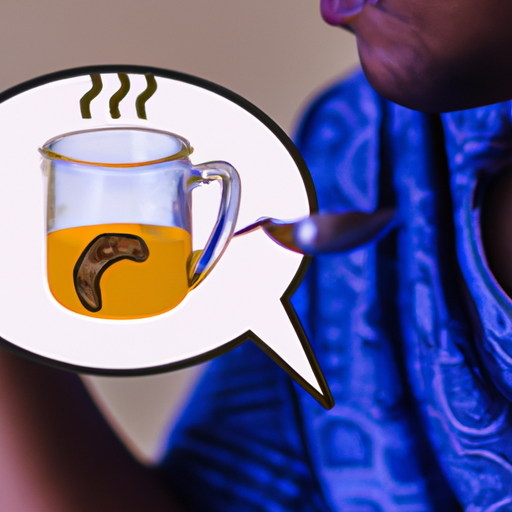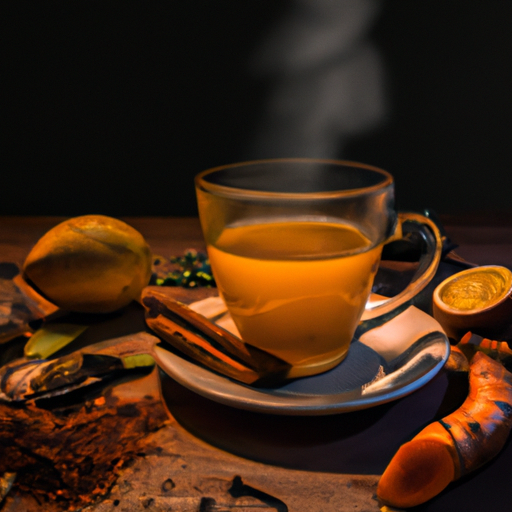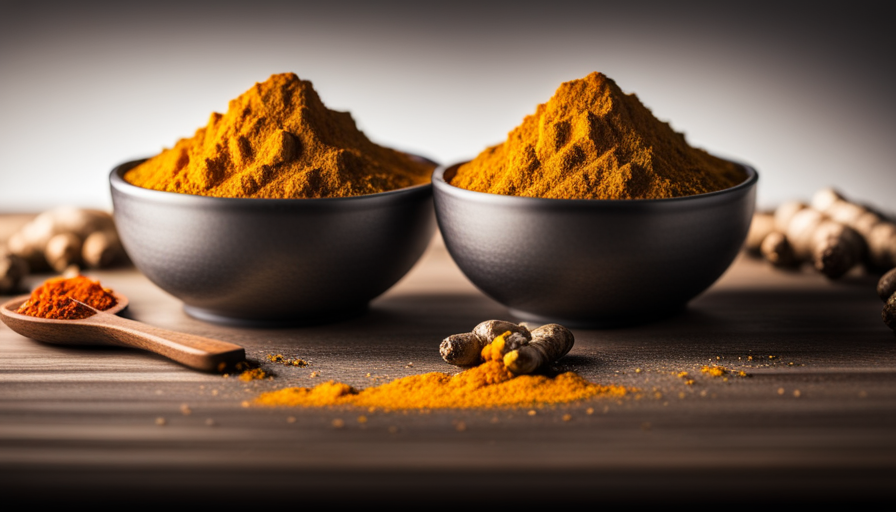I’ve always been intrigued by the idea of trying turmeric tea. I’ve heard about its many health benefits, but the big question is – what does it taste like? As someone who loves trying new flavors and blends of tea, turmeric tea has caught my attention. Therefore, I decided to do some research and give it a try.
Turmeric tea is made by steeping fresh or dried turmeric root in hot water, and sometimes adding other ingredients such as ginger, honey, or lemon. The taste profile of turmeric tea is often described as earthy, slightly bitter, and slightly spicy. However, the taste can vary depending on the preparation method and the ingredients used.
Some people find the taste of turmeric tea to be too strong or overpowering, while others enjoy its unique flavor. In this article, I will delve deeper into the taste of turmeric tea, the factors that affect its flavor, and some tips for making it taste better.
Key Takeaways
- Turmeric tea has an earthy, slightly bitter, and slightly spicy taste profile.
- Adding other ingredients like ginger, cinnamon, and black pepper can enhance the taste and health benefits of turmeric tea.
- Turmeric tea contains curcumin, an antioxidant with anti-inflammatory properties, which stimulates the immune system and reduces the risk of chronic diseases.
- It’s important to speak with a doctor before adding turmeric to the diet if taking any medications as taking too much turmeric can lead to gastrointestinal issues and may interact with certain medications.
Brief Overview of Turmeric Tea
You’ll love the warm, earthy flavor of turmeric tea, which is made by steeping grated or ground turmeric root in hot water. Not only is it delicious, but it also offers numerous health benefits.
Turmeric contains curcumin, an antioxidant with anti-inflammatory properties that can help reduce inflammation in the body and improve brain function.
To brew the perfect cup of turmeric tea, start by boiling water and adding freshly grated or ground turmeric root. Let it steep for 5-10 minutes, then strain the mixture and add a natural sweetener like honey or maple syrup to taste. You can also add other spices like ginger or cinnamon for added flavor and health benefits.
Now let’s dive into the taste profile of turmeric tea.
Turmeric Tea Taste Profile
Indulge in the warm and comforting flavors of this earthy and aromatic beverage. Turmeric tea has a unique taste profile that can be described as bitter, spicy, and slightly sweet.
The flavor profile of turmeric tea is complex and can differ depending on the preparation and ingredients used. Some people describe the taste as similar to ginger, with a slightly bitter aftertaste that lingers on the palate.
The addition of honey or lemon can enhance the sweetness and tanginess of the tea, while adding black pepper can bring out the spiciness of the turmeric.
Overall, turmeric tea has a distinctive taste that may not be for everyone. However, its flavor profile is what makes it a popular choice for many. The combination of earthy, spicy, and sweet notes creates a unique drinking experience that is both comforting and invigorating.
In the next section, we’ll explore the factors that affect turmeric tea taste and how to customize it to your liking.
Factors that Affect Turmeric Tea Taste
When it comes to the taste of turmeric tea, there are several factors that can influence its flavor profile. As someone who enjoys a good cup of turmeric tea, I’ve noticed that the type of turmeric used can greatly impact the taste.
The way the tea is prepared and any other ingredients added can also play a role in the overall taste experience.
Type of Turmeric Used
If you use fresh turmeric root to make your tea, you’ll notice a bold and earthy flavor that’s reminiscent of a deep forest after a rainstorm. The taste is quite distinct, with a subtle bitterness that’s balanced out by a slightly sweet aftertaste. The flavor of turmeric tea can also vary depending on the type of turmeric used. There are different varieties of turmeric that produce unique flavor variations. For instance, the Alleppey variety from India has a more pungent and spicy taste compared to the Madras variety, which is milder and sweeter.
To better understand the flavor variations of turmeric tea, take a look at the table below:
| Type of Turmeric | Flavor Profile |
|---|---|
| Madras | Sweet and Mild |
| Alleppey | Spicy and Pungent |
| Erode | Bitter and Earthy |
| Salem | Slightly Sweet and Nutty |
| Nizamabad | Robust and Smokey |
Using different types of turmeric can add complexity to your tea, and experimenting with various varieties can help you discover your favorite flavor profile. However, keep in mind that the quality of the turmeric root will also affect the taste of your tea. In the next section, I’ll discuss how the preparation method can influence the flavor of your turmeric tea.
Preparation Method
To maximize the flavor of your turmeric tea, you’ll want to pay attention to the preparation method. The steeping time and water temperature are crucial factors that can make or break the taste of your tea. Here are some tips to ensure that your turmeric tea is brewed to perfection:
- Use freshly boiled water at a temperature of 95°C to 100°C.
- Steep the tea for at least 5 minutes, but no longer than 10 minutes. Oversteeping can cause bitterness in the tea.
By following these guidelines, you can create a turmeric tea that’s rich, bold, and flavorful. However, the preparation method is only half the battle. The other ingredients added to the tea can also have a significant impact on its taste.
Other Ingredients Added
Adding other ingredients can completely transform the flavor profile of your turmeric tea. Popular blends include ginger, cinnamon, and black pepper. These ingredients not only add complexity to the taste but also enhance the health benefits of turmeric tea. For example, black pepper contains piperine, which helps increase the absorption of curcumin, the active ingredient in turmeric. Ginger and cinnamon have anti-inflammatory properties that complement the benefits of turmeric.
Another way to sweeten and flavor turmeric tea is by adding honey or maple syrup. These natural sweeteners provide a subtle sweetness to balance the earthy flavor of turmeric. Spices like cardamom and cloves can also be added to create a chai-like flavor. The table below showcases some possible ingredient combinations to try in your turmeric tea:
| Ingredients | Flavor Profile | Health Benefits |
|---|---|---|
| Ginger + Lemon | Refreshing and Citrusy | Immune-Boosting |
| Cinnamon + Honey | Sweet and Spicy | Anti-Inflammatory |
| Black Pepper + Milk | Creamy and Peppery | Enhanced Absorption |
As you can see, turmeric tea can be customized to suit your taste preferences and health needs. Now that we’ve explored the different ingredient options, let’s move on to the next section and discover the health benefits of turmeric tea.
Health Benefits of Turmeric Tea
The health benefits of turmeric tea are numerous, and it’s no wonder why this beverage has been a staple in Ayurvedic medicine for centuries. Recent turmeric tea research has shown that it can reduce inflammation, boost the immune system, and improve brain function.
Here are three specific ways that turmeric tea benefits your health:
-
Anti-inflammatory properties: Turmeric contains curcumin, which has been shown to reduce inflammation in the body. Chronic inflammation is linked to numerous diseases, including cancer, heart disease, and Alzheimer’s.
-
Improves brain function: Curcumin has also been shown to increase levels of brain-derived neurotrophic factor (BDNF), which is a growth hormone that helps to create new neural connections in the brain. This can improve cognitive function and reduce the risk of brain diseases.
-
Boosts immune system: Turmeric contains compounds that have been shown to stimulate the immune system, helping to fight off infections and illnesses.
With all of these turmeric tea benefits, it’s no wonder that more and more people are incorporating this beverage into their daily routine. But how can you make it taste better? Let’s explore some tips for enhancing the flavor of your turmeric tea.
Tips for Making Turmeric Tea Taste Better
If you want your turmeric tea to have a more flavorful and enjoyable taste, try experimenting with different spices such as ginger, cinnamon, and cardamom. These spices not only add layers of flavor to your tea, but they also have their own set of health benefits.
You can play around with different flavor combinations and spice ratios to find the perfect balance that suits your taste buds. For example, adding a pinch of cinnamon and ginger to your turmeric tea can give it a warm and comforting taste.
You can also try using honey or maple syrup as a natural sweetener instead of sugar. Additionally, adding a splash of milk or a dairy-free alternative like almond milk can create a creamy texture and mellow out the strong flavor of turmeric.
Don’t be afraid to try different combinations until you find the perfect blend that satisfies your taste buds. Moving on to turmeric tea recipes, I’ve got some exciting ideas that you can try at home.
Turmeric Tea Recipes
Now you can easily make delicious turmeric tea at home with these simple recipes that will leave your taste buds craving for more.
There are many variations of turmeric tea, each with its unique flavors and benefits.
One way to make turmeric tea is by using fresh turmeric root, ginger, and black pepper. Simply grate the turmeric and ginger, add them to a pot of water with a pinch of black pepper, and bring the mixture to a boil. Let it simmer for about 10 minutes, strain, and enjoy.
Another popular way to make turmeric tea is by using turmeric powder and milk. To make this version, simply heat up a cup of milk and add a teaspoon of turmeric powder. You can also add honey or cinnamon for added sweetness and flavor.
Another option is to blend together turmeric, ginger, and honey with hot water for a creamy and spicy turmeric latte.
Now that you know how to make some delicious variations of turmeric tea, let’s explore how it compares to other types of tea.
Turmeric Tea vs. Other Teas
As a lover of tea, I’m always on the lookout for new blends and flavors to try. When it comes to turmeric tea, I’m intrigued by its unique taste and potential health benefits.
In this discussion, I’ll compare the taste of turmeric tea to other popular teas and explore the various health benefits that set it apart. So, join me as we sip and savor our way through this flavorful and aromatic comparison.
Taste Comparison
Compared to other teas, turmeric tea has a slightly earthy and spicy flavor that adds a unique kick to your taste buds. It’s not as bitter as green tea or as floral as chamomile, but it has its own distinct taste that can take some getting used to.
Here are three ways I’d describe the taste of turmeric tea:
-
Warm and cozy – Turmeric tea has a comforting taste that makes you want to curl up with a good book and relax.
-
Bold and zesty – The spiciness of turmeric adds a punch to the tea that wakes up your senses.
-
Slightly bitter – While not as bitter as green tea, turmeric tea does have a slightly bitter aftertaste that may take a few sips to appreciate.
While taste preferences vary from person to person, I find that turmeric tea’s unique flavor profile is definitely worth trying. And the best part? Along with its taste, turmeric tea also offers a plethora of health benefits.
Health Benefits Comparison
You’ll be amazed at the range of health benefits that turmeric tea can offer you. Not only does it taste great, but it’s also packed with antioxidants and anti-inflammatory properties that can help reduce the risk of chronic diseases such as heart disease, cancer, and Alzheimer’s.
Turmeric supplements are a great way to get these benefits, but drinking turmeric tea is a delicious and easy way to incorporate the spice into your daily routine. Turmeric can also be used in cooking, adding a warm, earthy flavor and vibrant yellow color to dishes.
You can use it in curries, soups, and even smoothies for an extra health boost. When buying and storing turmeric, look for fresh roots that are firm and free of blemishes. Store them in a cool, dry place, or even in the fridge to keep them fresh for longer.
With all the health benefits and versatility of turmeric, it’s definitely worth adding to your diet.
Buying and Storing Turmeric
When you’re buying turmeric, make sure to choose roots that are firm and not shriveled. This is an indication of freshness, which is crucial when it comes to the taste and benefits of turmeric tea. You can find fresh turmeric roots in many grocery stores, health food stores, and specialty markets. However, the best places to purchase fresh turmeric are Asian markets and Indian stores. They usually have a wider selection of fresh turmeric and you can also find it at a more affordable price.
To make the most out of your turmeric tea, it’s important to store the roots properly. Turmeric roots can be stored in the refrigerator for up to 3 weeks if they are not peeled yet. If you have already peeled them, make sure to keep them in an airtight container in the refrigerator and use them within a week. You can also freeze turmeric roots for up to 6 months. Just make sure to wrap them tightly in plastic wrap or aluminum foil before putting them in the freezer to prevent freezer burn. By following these freshness tips and proper storage techniques, you can ensure that your turmeric tea will taste and smell delicious every time.
Moving on to precautions and side effects, it’s important to be aware of any potential risks when consuming turmeric tea.
Precautions and Side Effects
It’s crucial to be aware of potential risks before consuming turmeric, as there are some precautions and side effects that should be taken into consideration.
One of the most important precautionary measures is to ensure that you are taking the correct dosage. While turmeric is generally safe for most people, taking too much of it can lead to gastrointestinal issues such as nausea, diarrhea, and stomach upset. It’s recommended that you stick to the amount specified on the product label or as directed by your healthcare provider.
Another thing to keep in mind is that some people may be allergic to turmeric, which can cause symptoms such as hives, itching, and swelling. Additionally, turmeric may interact with certain medications, such as blood thinners, and can increase the risk of bleeding. If you are taking any medications, it’s important to speak with your doctor before adding turmeric to your diet.
Overall, while turmeric is a beneficial spice with plenty of health benefits, it’s important to be aware of potential risks and take the necessary precautions before consuming it.
Frequently Asked Questions
How much turmeric should I use to make a cup of turmeric tea?
I know the thought of using too much turmeric can be overwhelming, but trust me, a little goes a long way. For a single cup of turmeric tea, I recommend using 1 teaspoon of turmeric and adding some ginger for extra flavor and health benefits. Check out my favorite turmeric tea recipe online!
Can turmeric tea be consumed hot or cold?
I love sipping on a steaming cup of turmeric tea, especially on a chilly morning. However, it can also be enjoyed iced on a hot summer day! There are different ways to prepare turmeric tea, but I prefer using grated fresh turmeric root and adding a squeeze of lemon for a zesty kick. Hot or cold, it’s a delicious and healthy beverage option.
Is it safe to consume turmeric tea every day?
Daily consumption of turmeric tea has numerous benefits such as reducing inflammation and boosting immunity. However, excessive intake may pose risks such as stomach upset and interact with medications. Be mindful of moderation.
Can I add sweeteners like honey or sugar to turmeric tea?
I like to sweeten my turmeric tea with honey. It complements the earthy flavor while providing health benefits. Alternatives to sweeteners include cinnamon or stevia. Experiment and find what works for you!
Can turmeric tea be made with fresh turmeric root instead of powdered turmeric?
Coincidentally, I just made turmeric tea with fresh turmeric root! It has a brighter, more pungent flavor than powdered turmeric. Plus, using fresh turmeric root has added health benefits. Just make sure to store it properly in the fridge.
Conclusion
Wow, I never thought drinking turmeric tea could be so satisfying! The taste is definitely unique, with a slightly bitter and earthy flavor that can be enhanced with some sweeteners or spices. However, it’s worth noting that the taste can vary depending on the quality and preparation of the turmeric and other ingredients.
Despite its taste, turmeric tea has many health benefits that make it worth exploring. From reducing inflammation to boosting immunity, it’s a great addition to any healthy lifestyle. And with the right recipe and ingredients, you can make a delicious cup of turmeric tea that’s sure to please your taste buds.
So go ahead, give it a try and see what all the fuss is about!










